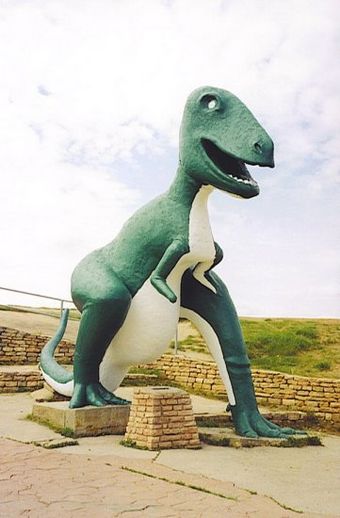Dinosaur Park facts for kids
Quick facts for kids |
|
|
Dinosaur Park
|
|

Tyrannosaurus rex sculpture
|
|
| Location | Rapid City, South Dakota, United States |
|---|---|
| Built | May 22, 1936 |
| Architect | Emmet Sullivan |
| NRHP reference No. | 90000956 |
| Added to NRHP | June 21, 1990 |
Dinosaur Park is a fun place to visit in Rapid City, South Dakota, United States. It opened on May 22, 1936. This park has seven big dinosaur statues on a hill. From here, you can see the whole city!
The park was built to attract people visiting the Black Hills and Mount Rushmore. The city of Rapid City worked with the Works Progress Administration (WPA) to create it. The WPA was a government program that helped people find jobs during a tough time. The dinosaur statues were designed by an artist named Emmet Sullivan. He also designed other famous statues, like the Apatosaurus at Wall Drug in Wall, South Dakota.
You can find Dinosaur Park at 940 Skyline Drive. The city of Rapid City takes care of it. It's free to enter, but some stairs might make it hard for people using wheelchairs. The park became a special historical site on June 21, 1990. It's listed on the National Register of Historic Places.
Meet the Dinosaurs!
At Dinosaur Park, you can see many different dinosaur statues. These include the huge Apatosaurus, the mighty Tyrannosaurus rex, and the horned Triceratops. You'll also find the armored Stegosaurus and the duck-billed Edmontosaurus annectens.
Later, a Protoceratops and a Dimetrodon were added. You can find these two near the gift shop and parking lot. It's interesting to know that Dimetrodon isn't actually a dinosaur! It's an ancient animal more closely related to mammals than to reptiles. Most of the dinosaurs chosen for the park are based on real fossils found in South Dakota and the Western United States.
How the Dinosaurs Were Made
The dinosaur statues were built using strong materials. First, workers used 2-inch (about 5 centimeters) black iron pipes to create the skeleton. Then, they added a wire mesh frame. Finally, they covered everything with a layer of concrete.
When they were first built, the statues were gray. But by the 1950s, they were painted bright green with white undersides! Since the statues were made in the 1930s, they show how people thought dinosaurs looked back then. For example, some statues show dinosaurs with their tails dragging on the ground. Today, we know many dinosaurs held their tails up.
Some parts of the statues have changed over time. The T. rex statue originally had three claws on each hand and sharp teeth. Over the years, these parts got damaged or lost. Now, its hands look like stumps, and most of its teeth are gone. Old postcards show what the T. rex looked like when it was new. The Stegosaurus also had a shorter tail with four spikes. Recently, these tail spikes were removed, perhaps for safety, and its tail was made much longer.
Gallery of Dinosaur Park Images




